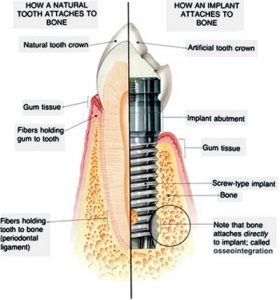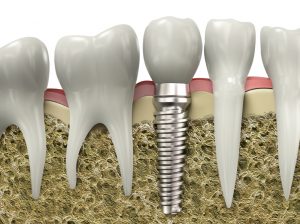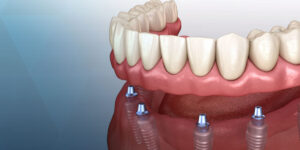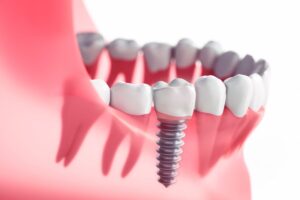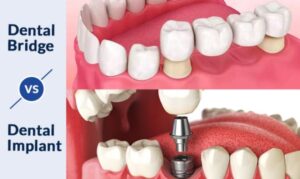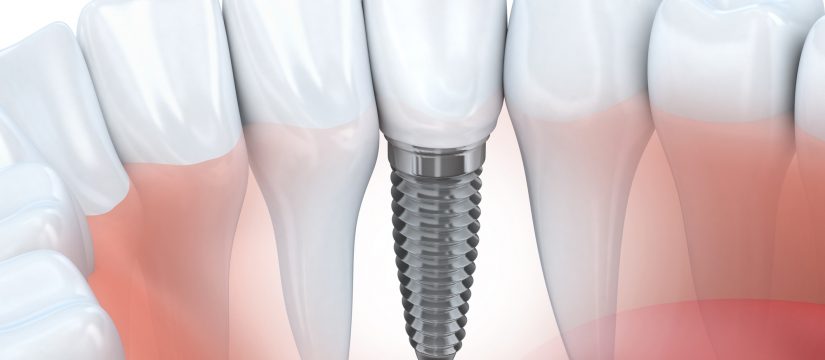
Considering cosmetic dental implant options to enhance your smile and confidence? Our succinct guide unpacks how these sophisticated fixtures not only improve the look of your teeth but also reinforce oral health. From choosing the right type to comprehending the implantation process, you’ll learn the key to a successful and enduring dental transformation.
Key Takeaways
- Cosmetic dental implants enhance aesthetics and improve oral functionality by preventing bone deterioration and maintaining jawbone structure, thus contributing to overall dental health.
- There are various types of dental implants, such as endosteal, subperiosteal, and zygomatic, including systems like All-on-4 and All-on-6, each serving different patient needs and conditions with specific placement techniques.
- The implant process involves several stages from initial consultation to surgical procedure and aftercare, with costs varying and financing options available; implants generally have a high success rate and can be a more beneficial long-term investment compared to bridges or dentures.
Understanding Cosmetic Dental Implants
Cosmetic dental implants offer more than just an aesthetic upgrade. They serve a dual purpose of enhancing aesthetics while improving oral functionality. Beyond the surface, these implants play a crucial role in preventing bone deterioration by stimulating the jawbone in areas where teeth are missing. For those seeking expert care, dental implants in Rockville are a reliable solution to restore both form and function to your smile.
This dual action makes cosmetic dental implants a preferred choice among cosmetic dental procedures and cosmetic dental treatments, highlighting the importance of oral health and overall well-being in cosmetic and implant dentistry, including the popular cosmetic procedure.
The Components of a Cosmetic Dental Implant
Each dental implant is a marvel of engineering, designed to replicate the structure and functionality of a natural tooth. Each implant comprises three key components:
- The crown: the visible part of the dental implant, designed to mimic the appearance and function of a natural tooth.
- The abutment: connects the crown to the fixture.
- The fixture: the part that is surgically placed into the jawbone to provide a stable foundation for the implant.
The three-part structure of a dental implant consists of:
- The fixture, which acts like the tooth root and anchors the implant into the jawbone.
- The abutment, which serves as the middle man, connecting the crown to the fixture.
- The crown, which is the visible part of the implant and blends seamlessly with your natural teeth.
Together, these components form a sturdy and reliable tooth replacement for missing teeth, including a single missing tooth, while preventing tooth decay.
Reasons for Choosing Cosmetic Dental Implants
Opting for cosmetic dental implants entails more than just aesthetic considerations. These implants offer several benefits, including:
- Preventing the deterioration of the jawbone structure, a common issue when a tooth is lost or extracted
- Contributing to better oral health due to their ease of maintenance
- Helping maintain the natural appearance of one’s smile by preventing the movement of adjacent teeth
Unlike dentures, which may require frequent adjustments or replacements and do not protect against bone loss, dental implants offer a more permanent solution to tooth loss and actively prevent bone atrophy.
Types of Cosmetic Dental Implants
The world of cosmetic dentistry offers a variety of dental implants, each designed to cater to specific patient needs and conditions. Cosmetic dentistry utilizes three main types of implants: endosteal, subperiosteal, and zygomatic. These implants offer a range of options for patients seeking dental enhancements. These differ mainly in terms of their placement within or on the jawbone. Grasping these various types can assist you and your dentist in selecting the most suitable dental implant for your particular requirements.
Endosteal Implants
Endosteal implants are the most common type used in cosmetic dentistry. These implants offer a long-term tooth replacement solution, thanks to their durability and ability to support jawbone preservation. Here are some key features of endosteal implants:
- Made of titanium
- Designed to fit securely within the jawbone, mimicking a natural tooth root
- Versatile and capable of supporting various dental restorations, including individual crowns, bridges, and implant-supported dentures
With their numerous benefits, endosteal implants are a popular choice for those seeking a reliable and effective tooth replacement option.
However, to be considered for endosteal implants, you should be in good overall health, possess adequate jawbone density to support the implant, and have healthy gums.
Subperiosteal Implants
Subperiosteal implants differ from endosteal implants in their placement. Instead of being anchored into the jawbone, they rest on top of the jawbone but within the gum tissue. These implants are ideal for patients with insufficient bone height who are not suitable for bone grafting.
So, if you need full mouth restorations and have minimal bone height, subperiosteal implants could be your ticket to a beautiful smile.
Zygomatic Implants
Zygomatic implants offer a unique solution for patients with severe bone loss in the upper jaw. Instead of being anchored into the jawbone, these implants are anchored into the zygomatic bone (the cheekbone). As a result, they provide a graftless solution for upper jaw restoration, offering quicker recovery and immediate load possibilities.
If you have insufficient bone density in the upper jaw and are not suitable for bone grafting, zygomatic implants may be the perfect solution for you.
All-on-4 and All-on-6 Implants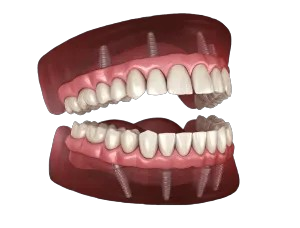
For those in need of a full-arch prosthesis, the All-on-4 and All-on-6 dental implant systems offer a promising solution. These systems use four or six implants respectively to support a full set of teeth.
Benefits of All-on-4 and All-on-6 dental implant systems:
- Designed to maximize the use of available bone
- Often eliminate the need for bone grafting
- More cost-efficient as fewer implants are needed compared to a full set of individual implants.
Implementing these systems soon after tooth loss is advisable to prevent bone atrophy and take advantage of the existing bone structure.
The Cosmetic Dental Implant Process
The journey to a beautiful smile with dental implants involves several stages, from the initial consultation to the dental implant surgeries and finally, the aftercare. Each stage plays a vital role in ensuring the success and longevity of your dental implants.
We’ll examine each stage for a more comprehensive understanding of the process.
Initial Consultation and Assessment
Prior to beginning your dental implant journey, an initial consultation and assessment are required. This involves a thorough evaluation and preparation for the upcoming treatment. During this stage, your dentist will assess your jawbone density. If it’s not sufficiently thick or is too soft, bone grafting may be indicated to ensure a solid base for the dental implants.
Your treatment plan will be developed considering your long-term oral health, aesthetic desires, and financial considerations, including budget and insurance coverage.
Surgical Procedure
Once your treatment plan is in place, you’ll proceed to the surgical phase of dental implant procedures. This involves opening the gum tissue to expose the bone and then accurately drilling to insert the metal post that serves as the implant. Various anesthesia and sedation methods are available during the procedure, such as general anesthesia, IV sedation, or local anesthetics, to ensure your comfort.
The total healing time following a dental implant procedure typically ranges from 2 to 5 months, within which the implant integrates with the bone and the gum heals around the abutment. After surgery, you’ll be equipped with pain management strategies to ensure your comfort.
Aftercare and Maintenance
Subsequent to your dental implant surgery, appropriate aftercare and maintenance are critical to ensure the success and lifespan of your implants. This includes maintaining adequate oral hygiene and having regular dental check-ups. It’s also important to be aware of potential complications and how to manage them. For instance, if complications arise due to failing implants, you’ll need to follow specific management strategies.
Additionally, lifestyle factors can impact the longevity of your implants. For example, smoking and drug use can adversely affect the success of your implants. Remember, even small food particles can become lodged under dental implants, emphasizing the importance of proper oral hygiene.
Costs and Financing Options for Cosmetic Dental Implants
Although the benefits of cosmetic dental implants are undeniable, comprehending the costs linked to this treatment is essential for your decision-making process. The costs of dental implants can vary, and there are several options available to help you manage these costs.
Average Costs of Dental Implants
The cost of dental implant treatment can range from a few thousand dollars up to $50,000, with some cases potentially exceeding this range. Various factors can affect the cost of dental implants, including the experience of your dentist and the complexity of the procedure.
For instance, in Washington DC, the price for a single tooth implant averages around $4,500, while replacing a complete arch of teeth will come at a higher cost.
Insurance Coverage for Cosmetic Dental Implants
Dental insurance can play a significant role in offsetting the costs of dental implants. However, the level of coverage varies based on location and the specific plan. While some insurance companies may consider dental implants as elective procedures and not cover them, others might provide partial or full coverage.
It’s advisable to check with your insurance carrier to understand your coverage.
Financing Options and Assistance Programs
Aside from insurance, various financing options can make cosmetic dental implants more accessible. These options include:
- Cash, checks, or credit cards
- In-house financing options offered by dental offices
- Third-party financiers like CareCredit and LendingClub, which provide flexible and affordable monthly payment plans
- No-collateral loans up to $60,000 available through Proceed Finance for patients with lower credit scores.
Potential Risks and Complications
As with any surgical procedure, dental implants come with potential risks and complications. However, it’s essential to remember that these complications are infrequent and that dental implants generally have a high success rate.
Common Risks and Complications
Certain individuals may face a higher risk of complications with dental implants. Some factors that may increase the risk include:
- Chronic conditions like diabetes
- Smoking
- Poor oral hygiene
- Gum disease
- Insufficient bone density
In addition, technical complications, such as issues with implant prostheses, can also occur. It is important to consult with a dental professional to assess your individual risk factors before undergoing dental implant surgery.
Biological complications associated with dental implants have also been documented in longitudinal studies.
Success Rates and Longevity of Dental Implants
Despite the potential risks, the success rate of dental implants is remarkably high, around 95%. With proper care, dental implants can last a lifetime, making them a worthwhile investment for your oral health.
The crowns of dental implants typically last about 15 years, while the implant posts may not require replacement. These success rates and longevity are supported by numerous studies, reinforcing the reliability of dental implants.
Comparing Cosmetic Dental Implant Options
After you have understood the nature of dental implants and the process, it becomes vital to contrast them with other treatment options. This comparison can help you make an informed decision based on the costs, benefits, and your specific circumstances.
Dental Implants vs. Bridges
In comparing dental implants and bridges, one must contemplate both immediate and long-term costs and benefits. While dental bridges often have a lower initial cost than implants and are more likely to be covered by insurance, they can lead to additional costs over time. Dental bridges can often be installed within two to three weeks without invasive surgery, while implants require a surgical procedure with a healing period that can take several months.
However, unlike bridges, dental implants do not damage neighboring teeth and are not susceptible to cavities.
Dental Implants vs. Dentures
Dental implants also possess significant benefits compared to traditional dentures. Implants provide a secure fit that prevents the sliding movement commonly experienced with dentures, enhancing functionality during activities such as eating and speaking. All-on-4 or All-on-6 dental implants offer long-term benefits over traditional dentures, including no need for relining or replacement and eliminating the need for daily removal for cleaning, as they are cared for like natural teeth.
Summary
Cosmetic dental implants are a transformative solution for those with missing teeth. They not only restore the function and aesthetics of your smile but also contribute significantly to your oral health. While the process involves several stages and a substantial financial investment, the long-term benefits of dental implants make them a worthwhile consideration. With various types of implants available and the possibility of insurance coverage and financing options, this treatment is more accessible than ever.
Frequently Asked Questions
What are the three main types of dental implants?
The three main types of dental implants are endosteal, subperiosteal, and zygomatic. Endosteal is the most common and safest, followed by subperiosteal, and zygomatic is the most complex.
What are the benefits of cosmetic dental implants?
Cosmetic dental implants restore the appearance and function of missing teeth while preventing jawbone deterioration. They achieve this by stimulating the bone where teeth are missing.
What is the average cost of a dental implant?
The average cost of a dental implant treatment can vary widely, ranging from a few thousand dollars to around $50,000, with some cases exceeding this range. In Washington DC, the average cost for a single tooth implant is approximately $4,500.
Are dental implants covered by insurance?
Insurance coverage for dental implants varies by location and insurance plan. Some plans may offer partial or full coverage, while others may not cover dental implants at all.
What are the potential risks and complications of dental implants?
While infrequent, potential risks and complications of dental implants include infection, poor healing, and implant failure. Overall, dental implants have a high success rate.



